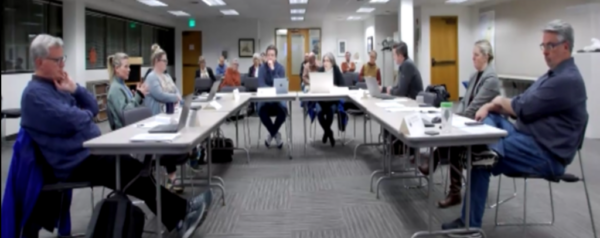The Edmonds Planning Board held a public hearing last week so that residents could voice their opinions and concerns regarding proposed amendments to Edmonds’ accessory dwelling unit (ADU) code. The amendments, which would allow for detached units known as DADUs, are designed to accommodate the Washington State Legislature’s 2023 passage of HB 1337. The bill directed cities to amend their development codes to include provisions for detached accessory dwelling units.
The Edmonds City Council has scheduled a work session at 6 p.m. Tuesday, March 5 on the proposed ADU code amendments. The council also had a presentation on the topic during its Feb. 27 business meeting.
During the Feb. 28 planning board meeting, City Planner Rose Haas highlighted proposed changes to the current ADU code including parking, decreased setbacks, square footage and height, critical areas and impact fees. Also, up to two DADUs may be added per lot.
Parking
Haas suggested that there should be no additional parking required for DADUs since two parking spaces are currently required for all single-family homes. The high cost of adding more parking may limit some homeowners’ ability to create extra housing. Furthermore, many lots do not have the capacity for a third parking space. DADUs within a quarter mile of a major transit stop are not required to have extra parking spaces.
Square footage and height
The update would limit DADUs up to 1,000 square feet of gross floor area in small lots (RS-6 and RS-8) and up to 1,200 square feet in large lots (RS-10, RS-12, RS-20). Gross floor area is defined as “interior habitable area of an accessory dwelling unit, not including unconditioned space.” Examples of unconditioned spaces include boiler rooms and attics.
All DADUs could be built to a maximum height of 24 feet, and housing should not cover more than 35% of the lot.
“Most single-family homes that are being built now are not 1,500 square feet,” Haas said. “So if you have 35% of your RS-6 already has a single-family home, you cannot put a DADU on that [lot].”


When Planning Board Vice Chair Lauren Golembiewski asked if the developers have analyzed many homes in Washington state can actually accommodate ADUs and DADUs, Haas replied that they have not.
Director of Planning and Development Susan McLaughlin said the city assumed that the growth target in Edmonds is “very low” based on the high cost of living in the area. “We want to make sure that these codes work for people to reduce the barriers and to make ADUs feasible,” she said.
Decreased setbacks
A building setback is the minimum distance which a building or other structure must be set back from a street. The update requires no rear setbacks for DADUs if that lot line borders an alley, regardless of their size. However, a rear setback may be reduced to a minimum of 5 feet if the DADU is 15 feet high or lower.
Critical areas
The Edmonds Planning Board has recommended that DADUs be allowed on lots that are within a critical area or its buffer zones as long as they meet protection standards in Edmonds Community Development Code (ECDC) Title 23, such as having a setback of a minimum of 15 feet away from buffers. Critical areas include wetlands, geological hazardous areas (steep cliffs, landslide and flood hazards) and wildlife habitats.
Impact fees
Under current Edmonds City Code (ECC) Chapter 3.36, DADUs are not considered to increase the population density of a single-family residential neighborhood. The planning board recommends that DADUs should be counted toward density requirements, which is consistent with the city’s 2024 Comprehensive Plan update. As a result, the city may charge impact fees to DADUs.
During both the Feb. 28 public hearing and in written comments, people shared a range of concerns about allowing DADUs in Edmonds. These include increasing population density, water and light pollution; less street parking, loss of Edmonds “character” and lack of accessibility for people with limited mobility.
People who support the inclusion of DADUs said that they would benefit aging people, single parents, people who work remotely and new families who could not afford typical single-family homes.
The Alliance of Citizens in Edmonds (ACE) wrote to the planning board that the city should stick with one-story DADUs because a 24-foot-tall building would reduce the view quality of certain neighborhoods. “Since homeowners with water views are assessed extra property taxes for views, allowing a new building that diminishes that view has an adverse impact on view homeowners,” ACE wrote.
Regarding off-street parking, Woodway resident John Brock proposed that ADUs and DADUs be treated as if they were “extensions of the primary residence, not as a separate dwelling.”
“Simply add the number of bedrooms in the ADU and DADU to the number of bedrooms in the primary residence,” Brock said. “Use the total to determine the number of off-street parking under existing zoning. The number of bedrooms are used for a variety of zoning requirements, why not our off-street parking as well?”
Woodway resident Bruce Wallace — who owns rental properties in Edmonds — suggested during public testimony that the planning board should check the percentages of ADUs and DADUs in Kirkland and Seattle that are developer-built vs. homeowner-built. “My own feeling from being in those areas, it’s probably between 85% to 90% developer [built],” he said. “So a lot the questions and objections being raised are more unlikely scenarios and that if Edmonds really wants to hit their growth targets, I’d encourage you to stay on track and don’t get sidetracked.”
Wallace also warned that having more than one ADU or DADU is not “feasible” on a single lot because of the extra cost of pollution they may generate, which can increase the cost of stormwater and sewage service.
Edmonds resident Jim Ogonowski suggested that the city first look at the minimum state legislative requirements for DADUs and leave options open for additional regulation, especially when it comes to placing them in the critical areas.
“Our GIS (geological information system) map identifies critical areas within the city,” he said. “So why not just use that, and let’s not make it more difficult than it needs to be.”
Urban planner Navyusha Pentakota warned the planning board about DADUs being used as unlimited short-term vacation rentals, which limits long-term rentals and impacts the quality of life for residents and affects neighboring streets. She suggested that the planning board review the short-term rental restrictions that Chelan County implemented.
You can learn more on the city’s ADU web page here.
— By Nick Ng




